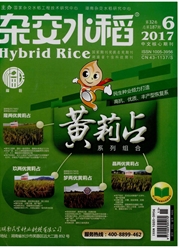

 中文摘要:
中文摘要:
利用13对SSR引物对2010年从湖南19个县(市)种植的44个水稻感病品种上分离到的169个稻瘟病单孢菌株进行了遗传多样性分析,结果在0.8的相似水平上将供试菌株划分为8个宗谱,其中L01宗谱为优势宗谱,占总菌株数的66.86%。病菌宗谱与菌株来源地及寄主品种之间关系复杂,来源于相同地区或来源于同一寄主品种的菌株亲缘关系相对较近,但不同地区稻瘟病菌生理小种分化程度不一,小种的分化程度与当地的地形地势以及该地区种植的水稻品种数量有一定关系。高海拔山区比丘陵区稻瘟病菌遗传多样性更丰富;在某一地区栽培品种组成多样化程度越高,该地区的稻瘟病菌遗传多样性越丰富。
 英文摘要:
英文摘要:
The genetic diversity of 169 blast fungus isolates collected from 44 susceptible rice cultivars widely grown in 19 counties(cities) in Hunan Province was analyzed by using 13 pairs of SSR markers.The results showed that these isolates were classified into 8 genetic lineages at 0.8 similar levels,among which L01 was the dominant lineage and its isolates accounted for 66.86% of the total ones.Most genetic lineages contained isolates from several source areas and many rice cultivars.The genetic relationship between the lineages and the source areas and the rice cultivars of isolates was complex.It was found that the isolates from same locations or from same rice cultivars had relatively close genetic relationship,but the differentiation of the blast fungus isolates varied in different locations.The genetic diversity of Magnaporthe oryzae was related to the terrain and the number of rice varieties of a location.There was a greater genetic diversity of Magnaporthe oryzae in mountainous regions with a high elevation than in hilly areas.The more rice varieties planted in a location,the greater genetic diversity of Magnaporthe oryzae was in the location.
 同期刊论文项目
同期刊论文项目
 同项目期刊论文
同项目期刊论文
 期刊信息
期刊信息
